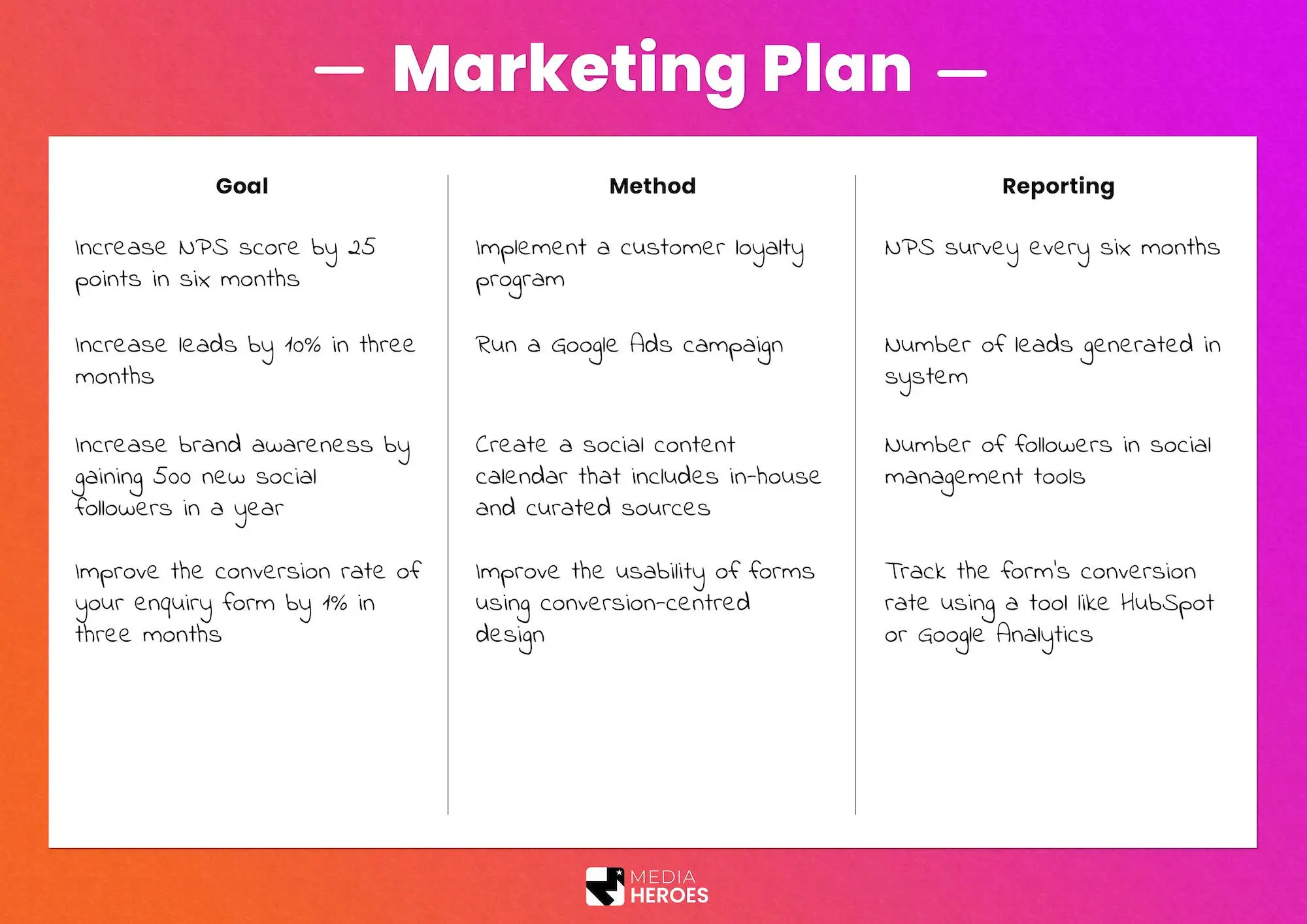How To Write A One Page Marketing Plan + Free Template
Marketing is something that a lot of companies struggle with, but it doesn’t have to be so complicated. Ideally, your marketing strategy should be a combination of campaigns that bring in measurable short term profit, and campaigns that help with long term growth. Once you’ve identified these key campaigns, they can be laid out in a one page marketing plan, which serves as a simplified overview of your marketing strategy, to be printed and stuck to the wall for all to see.
In this article, we explore the key elements of a one page marketing plan, offer some guidance on how to fill it out, and provide a free template for you to download and complete. This is everything you need to get started. Let’s jump in!
The elements of a one page marketing plan
Our one page marketing plan is broken down into three key areas: the goals you want to achieve, the methods for achieving them, and how you will report your performance. In our template, we divide these areas into columns so that you can easily fill in the information, as shown in the table below.
| Goals | Method | Reporting |
| Increase NPS score by 25 points in six months | Implement a customer loyalty program | NPS survey every six months |
| Increase leads by 10% in three months | Run a Google Adwords campaign | Number of leads generated in system |
| Increase brand awareness by gaining 500 new social followers in a year | Create a social media content planner that includes in-house and curated content | Number of followers in social management tools |
| Improve the conversion rate of your enquiry form by 1% in three months | Improve the usability of forms using conversion-centred design | Track the form’s conversion rate using a tool like HubSpot or Google Analytics |
Here’s a breakdown of how each area works:
Goals
Every team should have goals that help to accomplish the company’s broader business goals, and marketing is no exception. The first step of your marketing plan is to list out your goals, ensuring that they use the SMART method (Specific, Measurable, Achievable, Relevant, Time-Bound).
For example, if you wanted to increase the number of leads for the business, your goal might be to increase your leads by 10% in three months. Or if you wanted to build customer loyalty, you might aim to increase your Net Promoter Score by 25 points in six months.
Benchmarking can be handy when creating your goals, because it shows you how you’re faring against your competitors, and allows you to set targets to beat them. Check out our article on benchmarking to learn more.
Method
The methods are the marketing techniques you’ll use to achieve your goals. This is where your marketing experience comes in. If you want to increase your leads, you might consider running a digital ad campaign on Google or Facebook, which can immediately locate suitable leads and help to win more customers. The quick profits earned from this campaign give you the funds you need to run a longer-term SEO campaign alongside it, which can also bring a lot of leads, but takes much longer to do so. We call this profit-focused marketing, and we discussed it at length in our marketing budget article.
Marketing is a balancing act, and you’ll need a good understanding of which methods will help you to achieve your goals in the short and long term. If you’re unsure, research and experimentation is the way to find out!
Because our one-page marketing plan is an overview of your strategy, it doesn’t include the details on how you’ll carry out your methods. If necessary, you’ll need to create a separate document for these, to cover things like your approach, who will be completing the work, and which metrics you might need to report on. Which brings us to our final column.
Reporting
Reporting is how you’ll measure the success of your goal. If you’re trying to improve the conversion rate of your website’s enquiry form, you might use a tool like Google Analytics, or the form’s inbuilt reporting. If you’re trying to increase your organic website traffic, you’ll want to track the performance of your transactional SEO keywords, which can be done manually in Google itself.
As mentioned above, there’s many metrics that can be reported on for each marketing method you’re executing, but these are for a separate document. On your one page marketing plan, the reporting column is how you’ll measure the goal itself, and nothing more.
Free one page marketing plan template
We’ve created a free one page marketing plan template that you can download, print, and easily fill out. This can serve as a marketing guidepost for your team, and is a great way to remain focused on your goals.
If you’d like to download this template, you can do so using the button below:
Summary
A one page marketing plan is a simplified way to create a marketing strategy. By outlining your goals, the methods you use to achieve them, and the reporting metrics that will measure your performance, you can create a straightforward, no-nonsense strategy that can set you on the path to success. We hope this article and the template are useful for your marketing plans—thanks for reading!




